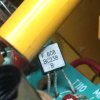I see Nige, isnt that a switch, or is it more of a selector.
Sounds like they are building a frame, with pwm pulses from each channel being generated by switching or selecting through its relevent control pot to the multivib, presumably theres some sync pulse or delay somewhere on the way.
Going to add the circuit to my scrapbook, I wouldnt use the ttl chip, but maybe the rf stages will be handy with a pic or arduino.
Not sure what you mean by that vari21, couldnt find anything on this page relevant.
Sounds like they are building a frame, with pwm pulses from each channel being generated by switching or selecting through its relevent control pot to the multivib, presumably theres some sync pulse or delay somewhere on the way.
Going to add the circuit to my scrapbook, I wouldnt use the ttl chip, but maybe the rf stages will be handy with a pic or arduino.
Not sure what you mean by that vari21, couldnt find anything on this page relevant.













